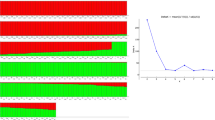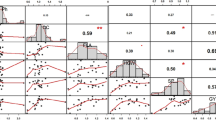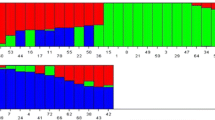Abstract
Reproductive-stage drought-stress is a major production constraint in rainfed rice ecosystem. Emergence of marker-assisted breeding strategies for develo** drought-tolerant rice varieties are being optimized through exploiting adaptive-traits for their increased contribution towards grain-yield under recurring-drought. Grain-yield is a complex-trait; requires knowledge of genetics and association among yield contributing component-traits. Current study was undertaken using 21 marker-assisted multi-drought-traits pyramided genotypes response for genetic variability and association of traits for grain-yield under aerobic and reproductive-stage drought conditions. Field evaluation was carried-out in two seasons and data was collected on various parameters. Path-coefficient analysis was used as a selection criterion to select yield contributing-traits and found nine phenotypic traits were having a positive direct-effect on grain-yield during both and/or at least one season under both moisture-regimes. The data from summer and Kharif seasons have been pooled within their respective moisture-regimes due to the non-significance of Levene’s test of homogeneity of variances and estimated BLUP values. ANOVA based on BLUP values revealed significant differences for moisture-conditions and also among genotypes. Phenotypic variation via. box-plots and histogram depicted mean phenotypic differences of traits under two moisture-regimes. Majority of the traits possessed high PCV, GCV with high heritability and GAM indicating higher trait expression and additive gene action lead to effectiveness of selection under drought/moisture stress. Grain-yield possessed a positive correlation with all the component-traits under consideration during both moisture-regimes. Selection of genotypes based on these component-traits were rewarding and seems to be better selection-criteria. Finally, we can end-up with superior-genotypes suitable for intermittent-drought conditions.





Similar content being viewed by others

References
Allard RW (1960) Principles of plant breeding. Wiley, New York, USA
Atlin GN, Laza M, Amante M and Lafitte HR (2004) Agronomic performance of tropical aerobic, irrigated, and traditional upland rice varieties in three hydrological environments at IRRI. The International Rice Research Insitute. DAPO 7777, Metro Manila, Philippines
Babu N, Hittalmani S, Shivakumar N, Nandini C (2011) Effect of drought on yield potential and drought susceptibility index of promising aerobic rice (Oryza sativa L.) genotypes. Elect J Plant Breed 2:295–302
Bhandari A, Sandhu N, Bartholome J, Cao-Hamadoun TV, Ahmadi N, Kumari N, Kumar A (2020) Genome-wide association study for yield and yield related traits under reproductive stage drought in a diverse indica-aus rice panel. Rice 13:1–22. https://doi.org/10.1186/s12284-020-00406-3
Burton GW, Devane EH (1953) Estimation of heritability in tall festca (Festuca arundinacea) from replicated clonal materials. Agron J 45:478–481
Chakraborty S, Chaturvedi HP (2014) Genetic variability in upland rice (Oryza sativa L) genotypes of Nagaland. Indian Res J Genet Biotechnol 6:374–378
Courtois B, Shen L, Petalcorin W, Carandang S, Mauleon R, Li Z (2003) Locating QTLs controlling constitutive root traits in the rice population IAC 165× Co39. Euphytica 134:335–345. https://doi.org/10.1023/B:EUPH.0000004987.88718.d6
Davierwala AP, Reddy APK, Lagu MD, Ranjekar PK, Gupta VS (2001) Marker assisted selection of bacterial blight resistance genes in rice. Biochem Genet 39:261–278. https://doi.org/10.1023/A:1010282732444
Dewey DR, Lu KH (1959) A path analysis of crested grass seed production. Agron J 51:515–518
Dowling NG, Greenfield SM, Fisher KS (1998) Sustainability of rice in the global food system. International Rice Research Institute. Los Banos, Philippines. p 404
Eltaher S, Baenziger PS, Belamkar V, Emara HA, Nower AA, Salem KF, Alqudah AM, Sallam A (2021) GWAS revealed effect of genotype× environment interactions for grain yield of Nebraska winter wheat. BMC Genomics 22:1–4. https://doi.org/10.1186/s12864-020-07308-0
Fahad S, Bajwa AA, Nazir U, Anjum SA, Farooq A, Zohaib A, Sadia S, Nasim W, Adkins S, Saud S, Ihsan MZ (2017) Crop production under drought and heat stress: plant responses and management options. Front Plant Sci 29(8):1147. https://doi.org/10.3389/fpls.2017.01147
Fahad S, Adnan M, Noor M, Arif M, Alam M, Khan IA, Ullah H, Wahid F, Mian IA, Jamal Y, Basir A (2019) Major constraints for global rice production. In: Advances in rice research for abiotic stress tolerance. Woodhead Publishing, Sawston, Cambridge. https://doi.org/10.2135/cropsci2006.03.0181
FAO (2016) Save and Grow in practice: maize, rice, wheat A guide to sustainable cereal production. ISBN 978-92-5-108519-6. pp120
Haradari C, Hittalmani S, Kahani F (2017) Genotype× environment interaction and stability analysis of yield traits among early generation-pyramid progeny families (EG-PPFS) in rice (Oryza sativa L.). SABRAO J Breed Genet 49:44–57
Haradari C (2013) DNA marker assisted multiple trait QTL pyramiding for drought tolerant traits in rice (Oryza sativa L.). Ph. D. Thesis, Univ Agric Sci, Bengaluru, India
Harijan Y, Katral A, Mahadevaiah C, Biradar H, Hadimani J, Hittalmani S (2021) Genetic analysis of reciprocal differences for yield and yield attributing traits in segregating populations of rice (Oryza sativa L.). J Pharmacogn Phytochem 10:614–621
Hittalmani S, Shivashankar G (1987) Out crossing on male sterile lines of rice. Mysore J Agric Sci 21:158–160
Hittalmani S (2010) Aerobic method of rice cultivation: water saving and safe environment. Green farming: Green farming vision 2.1(5)
Huke RE, Huke EH (1997) Rice area by type of culture: South, Southeast, and East Asia. International Rice Research Institute, Los Banos, Philippines
Jana K, Karmakar R, Banerjee S, Sana M, Goswami S, Puste AM (2018) Aerobic rice cultivation system: eco-friendly and water saving technology under changed climate. Agr Sci Tech 13:1–5
Johnson HW, Robinson HF, Comstock RE (1955) Estimates of genetic and environmental variability in soybean. Agron J 47:314–318
Kahani F, Hittalmani S (2015) Genetic analysis and traits association in F2 intervarietal populations in rice under aerobic condition. J Rice Res 3:152–157. https://doi.org/10.4172/2375-4338.1000152
Kim YJ, Cribbie RA (2018) ANOVA and the variance homogeneity assumption: exploring a better gatekeeper. Br J Math Stat Psychol Brit J Math Stat Psy 71:1–2. https://doi.org/10.1111/bmsp.12103
Korres NE, Norsworthy JK, Burgos R, Oosterhuis DM (2017) Temperature and drought impacts on rice production: An agronomic perspective regarding short and long term adaptation measures. Water Resou Rural Dev 9:12–27. https://doi.org/10.1016/j.wrr.2016.10.001
Kumar A, Bernier J, Verulkar S, Laffite HR, Atlin GN (2008) Breeding for drought tolerance: direct selection for yield, response to selection and use of drought- tolerant donors in upland and lowland-adapted populations. Field Crops Res 107:221–231. https://doi.org/10.1016/j.fcr.2008.02.007
Lafitte HR, Li ZK, Vijayakumar CH, Gao YM, Shi Y, Xu JL, Fu BY, Yu SB, Ali AJ, Domingo J, Maghirang R (2006) Improvement of rice drought tolerance through backcross breeding: evaluation of donors and selection in drought nurseries. Field Crops Res 97:77–86. https://doi.org/10.1016/j.fcr.2005.08.017
Levene H (1960) Levene test for equality of variances. Contributions to probability and statistics. pp 278–92
Liu H, Zhan J, Hussain S, Nie L (2019) Grain yield and resource use efficiencies of upland and lowland rice cultivars under aerobic cultivation. Agronomy 9:591. https://doi.org/10.3390/agronomy9100591
Lone AA, Jumaa SH, Wijewardana C, Taduri S, Redona ED, Reddy KR (2019) Drought stress tolerance screening of elite American breeding rice genotypes using low-cost pre-fabricated mini-hoop modules. Agronomy 9:199. https://doi.org/10.3390/agronomy9040199
Manickavelu A, Nadarajan N, Ganesh SK, Gnanamalar RP, Babu RC (2006) Drought tolerance in rice: morphological and molecular genetic consideration. Plant Growth Regul 50:121–138. https://doi.org/10.1007/s10725-006-9109-3
Manjappa UG, Shailaja H (2014) Association analysis of drought and yield related traits in F2 population of Moroberekan/IR 64 rice cross under aerobic condition. Int J Agric Sci 4:79–88
Mesterhazy S, Olah J, Popp J (2020) Losses in the grain supply chain: causes and solutions. Sustainability 12:2342. https://doi.org/10.3390/su12062342
Nguyen TL, Bui CB (2008) Fine map** for drought tolerance in rice (Oryza sativa L.). Omonrice 16:9–15
O’Toole JC (1982) Adaptation of rice to drought prone environments. In: Drought resistance in crops with emphasis on rice. IRRI, Los Baños, pp 95–213
O’Neill ME, Mathews KL (2002) Levene tests of homogeneity of variance for general block and treatment designs. Biometrics 58:216–224
Pandey S, Bhandari H, Hardy B (2007) Economic costs of drought and rice farmers co** mechanisms: a cross-country comparative analysis from Asia. International Rice Research Institute (IRRI), Los Banos, Philippines.
Price AH, Courtois B (1999) Map** QTLs associated with drought resistance in rice: progress, problems and prospects. Plant Growth Regul 29:123–133. https://doi.org/10.1023/A:1006255832479
Rawte S, Saxena RR, Verulkar SB (2021) Analysis of yield stability of rice (Oryza sativa L.) landraces under drought conditions with three different approaches. Indian J Genet 81:236–244
Roberts DP, Mattoo AK (2018) Sustainable agriculture- Enhancing environmental benefits, food nutritional quality and building crop resilience to abiotic and biotic stresses. Agric 8:8. https://doi.org/10.3390/agriculture8010008
Robinson GK (1991) That BLUP is a good thing: the estimation of random effects. Stat Sci 1:15–32
Saikumar S, Varma CM, Saiharini A, Kalmeshwer GP, Nagendra K, Lavanya K, Ayyappa D (2016) Grain yield responses to varied level of moisture stress at reproductive stage in an interspecific population derived from Swarna/O. glaberrima introgression line. NJAS-WAGEN J Life Sci 78:111–122. https://doi.org/10.1016/j.njas.2016.05.005
Serraj R, Kumar A, McNally KL, Slamet-Loedin I, Bruskiewich RM, Mauleon R, Cairns J, Hijmans RJ (2009) Improvement of drought resistance in rice. Adv Agron 103:41–98. https://doi.org/10.1016/S0065-2113(09)03002-8
Shen L, Courti B, Mcnally KL, Robin S, Li Z (2001) Evaluation on near isogenic lines of rice introgressed with QTL for root depth through marker aided selection. Theor Appl Genet 103:75–83
Singh P, Narayanan SS (2017) Biometrical techniques in plant breeding, 6th edn., Kalyani Publishers, New Delhi, India
Singh SK, Singh CM, Lal GM (2011) Assessment of genetic variability for yield and its component characters in rice (Oryza sativa L.). Res Plant Biol 1:73–76
Steele KA, Price AH, Shashidhar HE, Witcombe JR (2006) Marker-assisted selection to introgress rice QTLs controlling root traits into an Indian upland rice variety. Theor Appl Genet 112:208–221. https://doi.org/10.1007/s00122-005-0110-4
Sun X, Yang Z, Wang S, Zhang Q (2001) Identification of a 47-kb DNA fragment containing Xa4, a locus for bacterial blight resistance in rice. Theor Appl Genet 106:683–687. https://doi.org/10.1007/s00122-002-1117-8
Torres RO, Henry A (2018) Yield stability of selected rice breeding lines and donors across conditions of mild to moderately severe drought stress. Field Crops Res 220:37–45. https://doi.org/10.1016/j.fcr.2016.09.011
Tripathy JN, Zhang J, Robin S, Nguyen TT, Nguyen HT (2000) QTLs for cellmembrane stability mapped in rice (Oryza sativa L.) under drought stress. Theor Appl Genet 100:1197–1202
Uday G (2016) Evaluation of marker assisted introgressed multiple gene/QTL pyramided genotypes for abiotic and biotic stress in rice (Oryza sativa L.). Ph. D. Thesis, Univ Agric Sci, Bengaluru, India.
Venkataramana P, Hittalmani S (1999) Genetic variability on some important traits in two F2 segregants of rice (Oryza sativa L.). Crop Res 18:53–56
Venkataramana P, Hittalmani S (2003) Factors determining grain yield in early generation of rice (Oryza sativa L.) under non-submergence condition. Mysore J Agric Sci 7:38–44
Venuprasad R, Lafitte HR, Atlin GN (2007) Response to direct selection for grain yield under drought stress in rice. Crop Sci 47:285–293. https://doi.org/10.2135/cropsci2006.03.0181
Wang ZX, Yamanouchi U, Katayose Y, Sasaki T, Yano M (2001) Expression of the Pib rice-blast-resistance gene family is upregulated by environmental conditions favouring infection and by chemical signals that trigger secondary plant defences. Plant Mol Biol 47:653–661
Wang Z, Cheng J, Chen Z, Huang J, Bao Y, Wang J, Zhang H (2012) Identification of QTL with main epistatic and QTL×environment interaction effects for salt tolerance in rice seedlings under different salinity conditions. Theor Appl Genet 125:807–815. https://doi.org/10.1007/s00122-012-1873-z
Wassmann R, Jagadish SVK, Sumfleth K, Pathak H, Howell G, Ismail A, Serraj R, Redona E, Singh RK, Heuer S (2009) Regional vulnerability of climate change impacts on Asian rice production and scope for adaptation. Adv Agron 102:91–133. https://doi.org/10.1016/S0065-2113(09)01003-7
Wright S (1921) Correlation and causation. J Agric Res 20:557–585
Xu Q, Yuan XP, Yu HY, Wang YP, Tang SX, Wei X (2011) Map** QTLs for drought tolerance at seedling stage in rice using doubled haploid population. Rice Sci 18(1):23–28. https://doi.org/10.1016/S1672-6308(11)60004-8
Yadav R, Courtois B, Huang N, McLaren G (1997) Map** genes controlling root morphology and root distribution in a doubled haploid population of rice. Theor Appl Genet 94:619–632. https://doi.org/10.1007/s001220050459
Zeng D, Tian Z, Rao Y et al (2017) Rational design of high-yield and superior-quality rice. Nat Plants 3:17031. https://doi.org/10.1038/nplants.2017.31
Zhang J, Zheng HG, Aarti A, Pantuwan G, Nguyen TT, Tripathy JN (2001) Locating genomic regions associated with components of drought resistance in rice: comparative map** within and across species. Theor Appl Genet 103:19–29
Zhao DL, Atlin GN, Amante M, Cruz MT, Kumar A (2010) Develo** aerobic rice cultivars for water-short irrigated and drought-prone rainfed areas in the tropics. Crop Sci 50:2268–2276. https://doi.org/10.2135/cropsci2010.10.0028
Acknowledgements
First author sincerely acknowledges Indian Council of Agricultural Research (ICAR) for providing Junior Research Fellowship (JRF) to pursue M.Sc. degree programme [File number: EDN/1/26/2015-Exam Cell].
Funding
No fund was available for this work.
Author information
Authors and Affiliations
Contributions
Design of the experiment: AK and SH, Conduct of the experiments: AK, JH and AYR, Statistical analyses: YH and HB, Drafting of manuscript: AK, HB and SH.
Corresponding author
Ethics declarations
Conflict of interest
On behalf of all authors, the corresponding author states that there is no conflict of interest.
Human or animal participants
This article does not contain any studies with human participants or animals performed by any of the authors.
Additional information
Publisher's Note
Springer Nature remains neutral with regard to jurisdictional claims in published maps and institutional affiliations.
Supplementary Information
Below is the link to the electronic supplementary material.
Rights and permissions
About this article
Cite this article
Katral, A., Biradar, H., Harijan, Y. et al. Genetic analysis and traits association study in marker-assisted multi-drought-traits pyramided genotypes under reproductive-stage moisture stress in rice (Oryza sativa L.). Euphytica 218, 21 (2022). https://doi.org/10.1007/s10681-022-02974-5
Received:
Accepted:
Published:
DOI: https://doi.org/10.1007/s10681-022-02974-5



